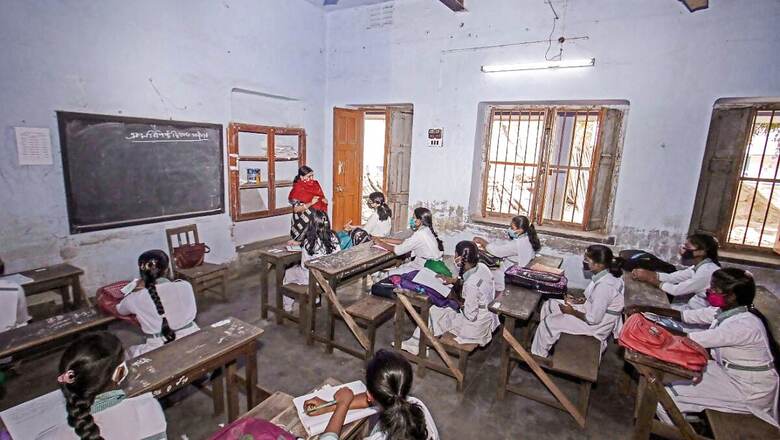
views
The economy is reopening with political rallies, mass protests, religious festivities, crowded markets, cinema halls and many going back to offices. Yet, at the same time, schools (barring classes 9 to 12) have remained closed despite the evidence of psychological trauma and learning loss during the pandemic.
The Childline 1098 helpline saw a 50 per cent increase in the number of calls received since the lockdown started. This raises a fundamental question about the priority the government places on education. The evidence is clear.
Check the learning loss
A recent study by the Azim Premji Foundation has shown that nearly 92 per cent children between Classes 2 and 6 had completely forgotten at least one specific ability in language; around 82 per cent had lost one specific ability in Mathematics. More critically, many children will not return to school at all. Experts estimate that the number of out-of-school children could double in a year. The likelihood of dropout increases with the decreasing wealth quintile. Many of those who will not return to schools will become victims of child labour and child marriage. The ILO (International Labour Organization) has urged India’s government to safeguard children from falling into child labour.
As we aim to recover our GDP growth rates, we ignore the proven connection between schooling and development and growth. The World Bank has calculated that the prolonged closure of schools due to the Covid-19 pandemic in India may cause a loss of over $400 billion in the country’s future earnings. India cannot continue to subject its children to psychological trauma, subvert its human capital and sabotage its economy by blocking access to its schools.
Online learning: Not an alternative
One may, of course, argue that schooling has not stopped, with online learning offering an alternative. There is no denying the government’s efforts to push for distance education. Teachers have also worked hard to move to this new medium. However, there is also no denying the experience of children and parents.
At the height of the pandemic, the Oxfam India study showed that 80 per cent of parents who send their children to government schools reported that education was “not delivered” during the lockdown. Families did not have digital devices and access to digital medium of education. The shift to online education classes has had the most serious consequences for poorer households and marginalized social groups. It risks exacerbating gender and economic inequalities in an already unequal educational system.
Out of the poorest 20 per cent households in India, only 2.7 per cent have access to a computer and 8.9 per cent to internet facilities. Ninety-six per cent of STs and 96.2 per cent of SC households, who send their children to schools, lack access to a computer. These patterns may have changed during the lockdown, but the trends remain. According to ASER (Annual State of Education Report) 2020, 11 per cent of parents bought a phone during the lockdown to prevent an interruption in their child’s learning. This is woefully inadequate given that only about one-third of the surveyed children had access to online learning. Online education remains fundamentally exclusionary.
Facing risks, Addressing them
Recognizing the limitations of online learning and calling for reopening of schools for face-to-face instruction, particularly for India’s youngest students do not, of course, mean ignoring the risks. At the peak of the lockdown, 40 per cent schools were being used as quarantine centres—and only 54 per cent schools have adequate WASH (water, sanitation and hygiene) facilities. In the absence of significant improvement in infrastructure in schools or concrete steps to ensure child safety amid the pandemic, parents are justifiably apprehensive about sending children to school. Indeed, a recent pre-Budget survey by the Fight Inequality Alliance India found that 97 per cent people want additional funding for adequate sanitation and handwashing facilities in schools to ensure safe reopening.
However, the Budget fails to provide additional resources for strengthening WASH facilities in schools, which is likely to negatively impact attendance of students after reopening, further increasing the learning loss, especially among the most marginalized children.
Other countries have made different choices. Denmark and Norway reopened schools early in April/May in a staggered manner without a wave of infection. When the UK opted for a second nationwide lockdown in the first week of November, it kept schools open while closing non-essential business. In some instances, reopening schools did contribute to an increase in infection, but then so does any reopening activity. The government, in this case, took steps to ensure safe reopening.
Time to Reopen schools
It is time to reopen schools by putting in place clear Standard Operating Procedures (SoPs). Teachers should also be considered as frontline workers and receive priority immunization. Schools need to be supported by putting in place measures like thermal checking, hand sanitizing, provision of masks, enhanced WASH facilities, providing quarantine rooms and COVID testing.
It is time to introduce face-to-face classes in shifts and with children attending on alternate days. While distancing may be difficult in urban areas, the fact that the majority of India’s rural schools are small is a blessing. According to the government’s statistics, almost 45 per cent of India’s primary schools have an enrolment figure of less than 50 children. A good 19 per cent of primary schools have less than 25 children—these should be safe to reopen immediately. The journey may not be easy and would entail some out-of-the-box thinking. However, we really have no other option because we as a nation consider schooling important and do not want to sacrifice this generation’s future.
Read all the Latest News, Breaking News and Coronavirus News here


















Comments
0 comment